|
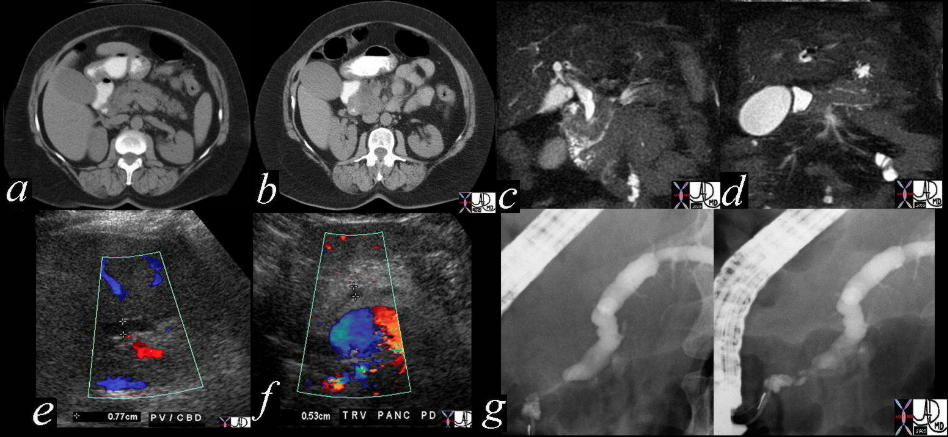 This combination studies includes CTscans, MRIs, US scans, and an ERCP. They suggest a subtle mass in the head of the pancreas with early bile duct dilatation and more obvious pancreatic duct involvement. This was a case of adenocarcinoma of the head of the pancreas. 41293a16c Courtesy Ashley Davidoff MD This combination studies includes CTscans, MRIs, US scans, and an ERCP. They suggest a subtle mass in the head of the pancreas with early bile duct dilatation and more obvious pancreatic duct involvement. This was a case of adenocarcinoma of the head of the pancreas. 41293a16c Courtesy Ashley Davidoff MD
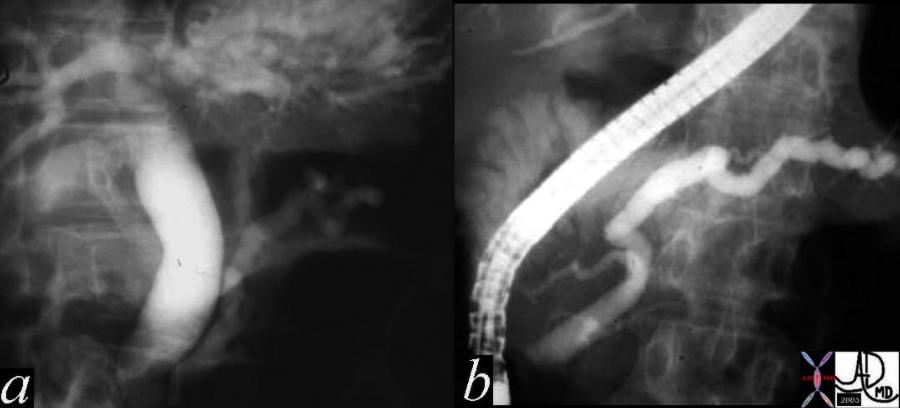 A 57 year old female presents with jaundice. Her ERCP shows dilatation of the bile duct and pancreatic duct – the “double duct” sign characteristic of adenocarcinoma of the head of the pancreas. In this case the stricture appears quite distal. Chronic pancreatitis can also rarely cause the “double duct” sign. In this case an ampullary carcinoma was the cause explaining the distal position of the strictures. 04655c03 Courtesy Ashley Davidoff MD A 57 year old female presents with jaundice. Her ERCP shows dilatation of the bile duct and pancreatic duct – the “double duct” sign characteristic of adenocarcinoma of the head of the pancreas. In this case the stricture appears quite distal. Chronic pancreatitis can also rarely cause the “double duct” sign. In this case an ampullary carcinoma was the cause explaining the distal position of the strictures. 04655c03 Courtesy Ashley Davidoff MD
The combination of images below reflects the changes of the above case using a multimodality approach with pathological proof.
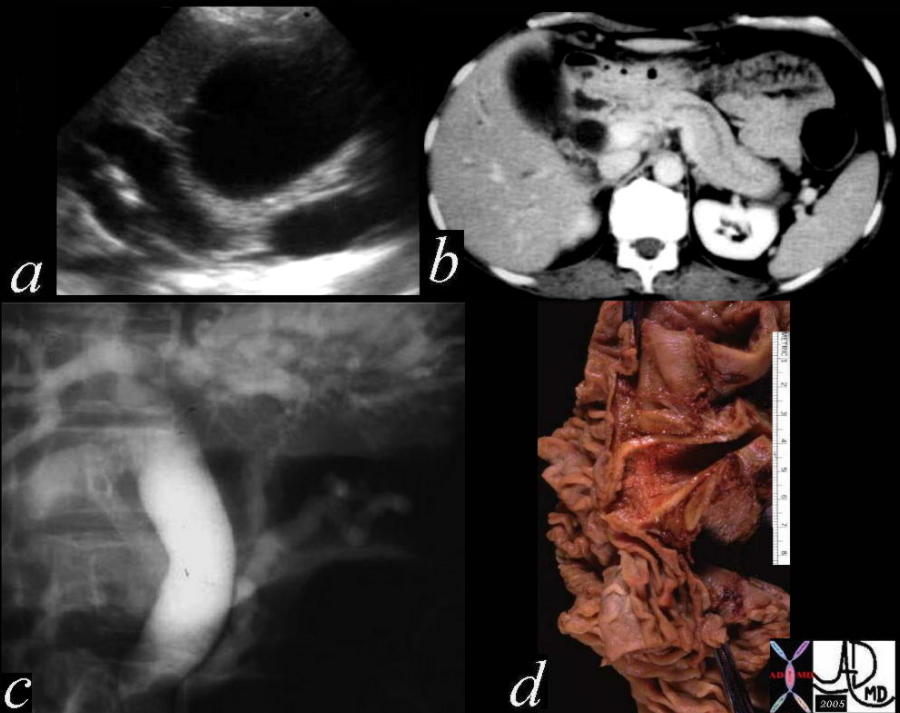 This is a series of images from the case history of a 57 year old female who presented with jaundice. The US image (a) shows a dilated bile duct and dilated pancreatic duct with no large mass between them. The CT shows a les impressive, but prominent pancreatic duct. The ERCP suggests a “double duct” sign. The pathology confirmed an ampullary carcinoma. 04655c05 Courtesy Ashley Davidoff MD This is a series of images from the case history of a 57 year old female who presented with jaundice. The US image (a) shows a dilated bile duct and dilated pancreatic duct with no large mass between them. The CT shows a les impressive, but prominent pancreatic duct. The ERCP suggests a “double duct” sign. The pathology confirmed an ampullary carcinoma. 04655c05 Courtesy Ashley Davidoff MD
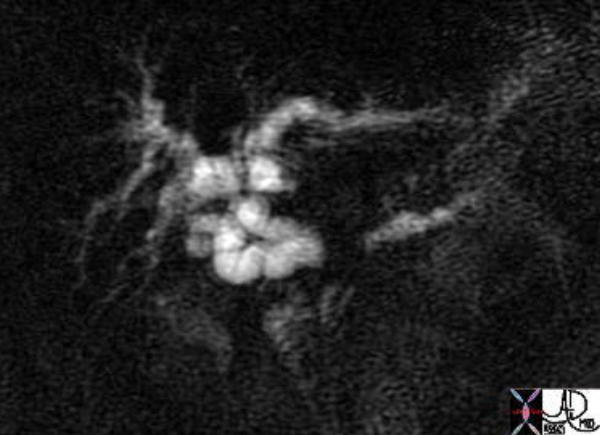 The image from an MRCP shows the MRI version of the double duct. The separation of the two ducts suggests a large size of the mass. This patient had pancreatic carcinoma. 41371 Courtesy of Ashley Davidoff MD The image from an MRCP shows the MRI version of the double duct. The separation of the two ducts suggests a large size of the mass. This patient had pancreatic carcinoma. 41371 Courtesy of Ashley Davidoff MD
The combination of images below reflects the changes of the above case at different levels. Cranially the liver is seen and caudally the pancreas is seen.
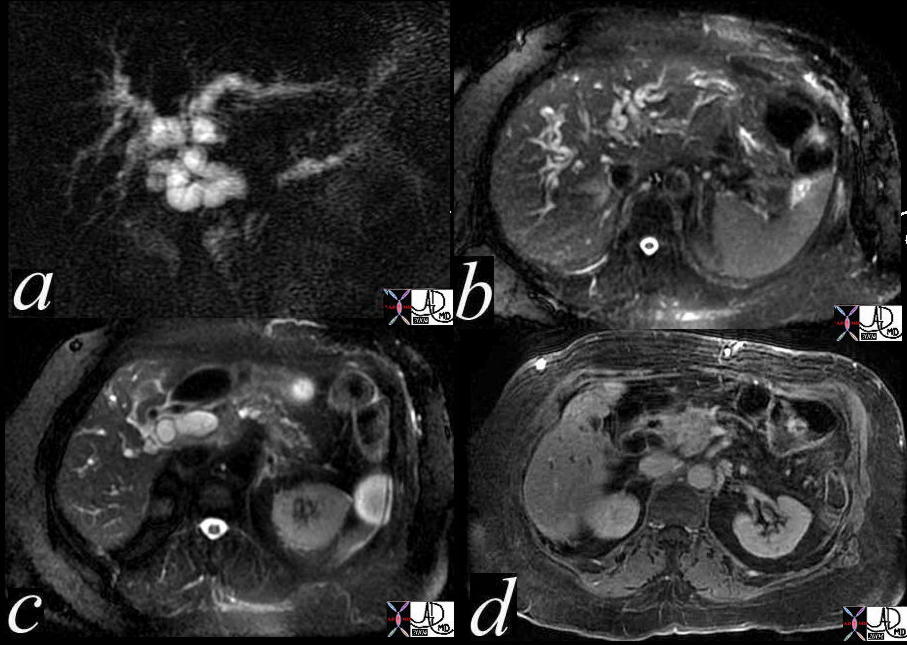 The image from an MRCP shows the MRI version of the “double duct” sign. The separation of the two ducts suggests a large size of the mass (a). Image b shows intrahepatic biliary dilatation, while image c shows CBD dilatation. Image d shows a mass in the head of the pancreas on the contrast enhanced sequence. This patient had pancreatic carcinoma. 41371c Courtesy of Ashley Davidoff MD The image from an MRCP shows the MRI version of the “double duct” sign. The separation of the two ducts suggests a large size of the mass (a). Image b shows intrahepatic biliary dilatation, while image c shows CBD dilatation. Image d shows a mass in the head of the pancreas on the contrast enhanced sequence. This patient had pancreatic carcinoma. 41371c Courtesy of Ashley Davidoff MD
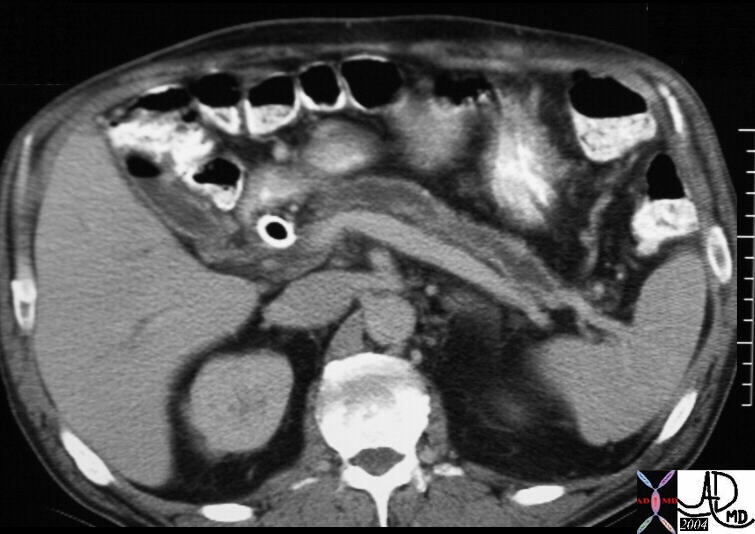 This CT study is a variation of the double duct sign. The biliary dilatation has been relieved by a stent while the pancreatic duct dilatation with secondary atrophy of the pancreas is quite apparent. This is a patient with pancreatic carcinoma.16312 Courtesy Ashley Davidoff MD This CT study is a variation of the double duct sign. The biliary dilatation has been relieved by a stent while the pancreatic duct dilatation with secondary atrophy of the pancreas is quite apparent. This is a patient with pancreatic carcinoma.16312 Courtesy Ashley Davidoff MD
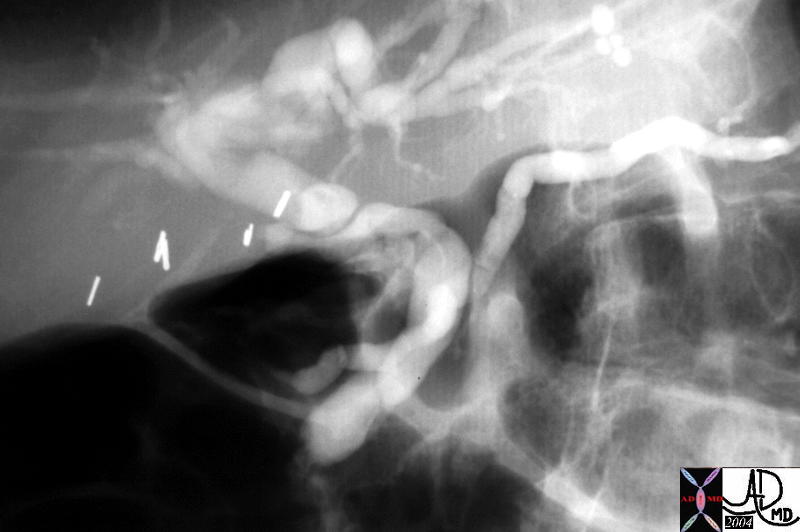 This is the injection of the MPD of the case above showing a small ventral duct of Wirsung. The case represents pancreas divisum as seen by ERCP. The main duct was found opening separately within the pailla near the opening of the CBD. 40617 Courtesy Ashley Davidoff MD This is the injection of the MPD of the case above showing a small ventral duct of Wirsung. The case represents pancreas divisum as seen by ERCP. The main duct was found opening separately within the pailla near the opening of the CBD. 40617 Courtesy Ashley Davidoff MD
The combination of images below reflects the changes of the above case using a multimodality approach.
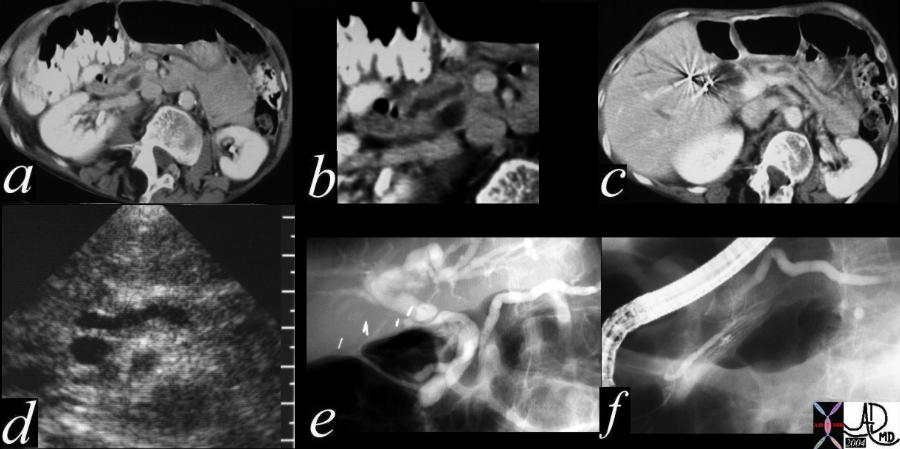 This combination series shows a dilated pancreatic duct in the head of the pancreas (a,b) as well as in the tail (c) The CBD is mildly dilated on US (d) The ERCP (e) shows that both ducts are dilated. At first glance a double duct sign seems likely since both ducts are dilated, but for different reasons. The main pancreatic duct drains into the accessory duct of Santorini, while the CBD drains in usual fashion into the ampulla. The smaller duct of Wirsung is seen mostly disconnected from the ductal system at large. This is a case of pancreas divisum. No pancreatic cancer was found on further workup 40617c01 Courtesy Ashley Davidoff MD This combination series shows a dilated pancreatic duct in the head of the pancreas (a,b) as well as in the tail (c) The CBD is mildly dilated on US (d) The ERCP (e) shows that both ducts are dilated. At first glance a double duct sign seems likely since both ducts are dilated, but for different reasons. The main pancreatic duct drains into the accessory duct of Santorini, while the CBD drains in usual fashion into the ampulla. The smaller duct of Wirsung is seen mostly disconnected from the ductal system at large. This is a case of pancreas divisum. No pancreatic cancer was found on further workup 40617c01 Courtesy Ashley Davidoff MD
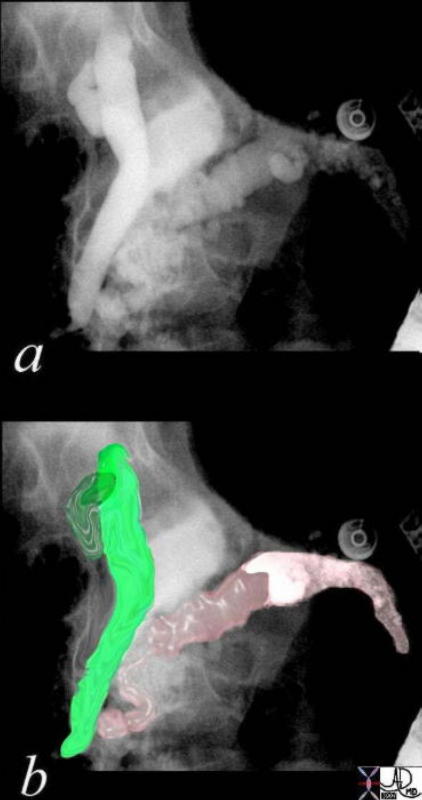 This is an ERCP showing a “double duct” sign. With the heavy intraductal calcification chronic alcoholic pancreatitis is definite. It is conceivable that the patient has a superimposed malignancy. In this case the double duct was caused by the strictures of chronic pancreatitis. 41245c06 Courtesy Ashley Davidoff MD This is an ERCP showing a “double duct” sign. With the heavy intraductal calcification chronic alcoholic pancreatitis is definite. It is conceivable that the patient has a superimposed malignancy. In this case the double duct was caused by the strictures of chronic pancreatitis. 41245c06 Courtesy Ashley Davidoff MD
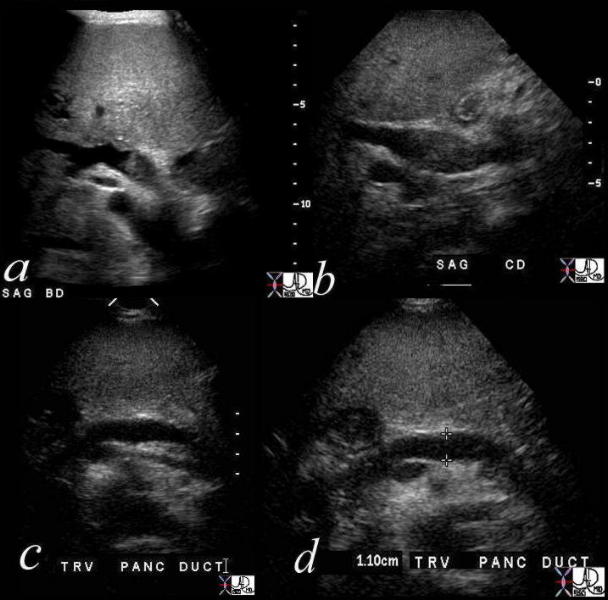 In this case we have a double duct sign as noted by US. The CBD is filled with sludge and pancreatic duct measures 11mm. This patient HIV positive and did not have pancreatic cancer. An HIV cholangiopathy, sludge impaction and infection involving both sites were considered. 41257c003 Courtesy Ashley Davidoff MD In this case we have a double duct sign as noted by US. The CBD is filled with sludge and pancreatic duct measures 11mm. This patient HIV positive and did not have pancreatic cancer. An HIV cholangiopathy, sludge impaction and infection involving both sites were considered. 41257c003 Courtesy Ashley Davidoff MD
|
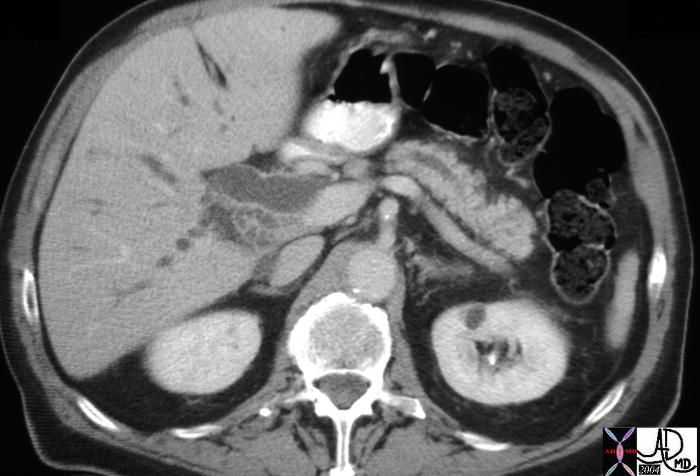
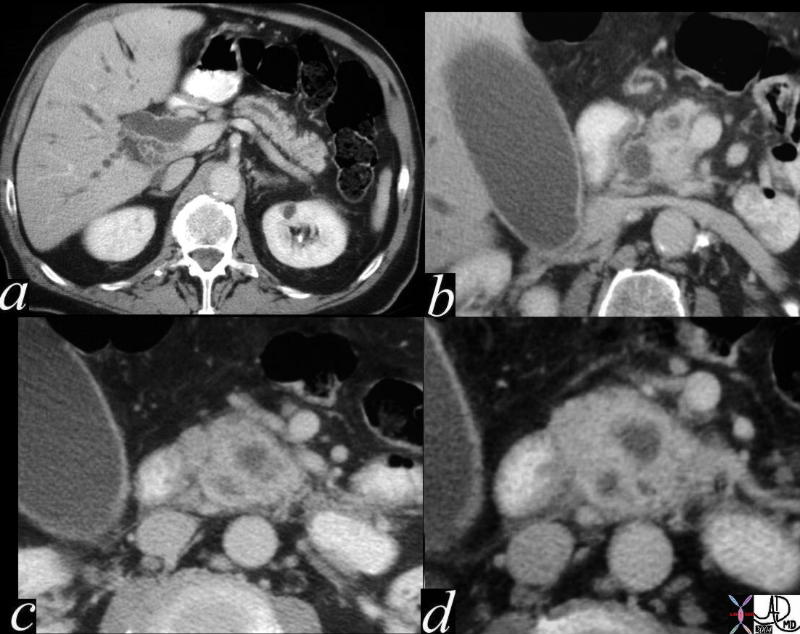 This is a classical example of a “double duct” sign. The dilated pancreatic duct and bile duct in a, almost point to the disease process in this image. The mass was as predicted to be in the head of the pancreas. In c and d, a relatively small hypodense mass was identified whose scirrhous nature, and critical location caused early obstructive jaundice. 40840c01 Courtesy Ashley Davidoff MD
This is a classical example of a “double duct” sign. The dilated pancreatic duct and bile duct in a, almost point to the disease process in this image. The mass was as predicted to be in the head of the pancreas. In c and d, a relatively small hypodense mass was identified whose scirrhous nature, and critical location caused early obstructive jaundice. 40840c01 Courtesy Ashley Davidoff MD
 This combination studies includes CTscans, MRIs, US scans, and an ERCP. They suggest a subtle mass in the head of the pancreas with early bile duct dilatation and more obvious pancreatic duct involvement. This was a case of adenocarcinoma of the head of the pancreas. 41293a16c Courtesy Ashley Davidoff MD
This combination studies includes CTscans, MRIs, US scans, and an ERCP. They suggest a subtle mass in the head of the pancreas with early bile duct dilatation and more obvious pancreatic duct involvement. This was a case of adenocarcinoma of the head of the pancreas. 41293a16c Courtesy Ashley Davidoff MD A 57 year old female presents with jaundice. Her ERCP shows dilatation of the bile duct and pancreatic duct – the “double duct” sign characteristic of adenocarcinoma of the head of the pancreas. In this case the stricture appears quite distal. Chronic pancreatitis can also rarely cause the “double duct” sign. In this case an ampullary carcinoma was the cause explaining the distal position of the strictures. 04655c03 Courtesy Ashley Davidoff MD
A 57 year old female presents with jaundice. Her ERCP shows dilatation of the bile duct and pancreatic duct – the “double duct” sign characteristic of adenocarcinoma of the head of the pancreas. In this case the stricture appears quite distal. Chronic pancreatitis can also rarely cause the “double duct” sign. In this case an ampullary carcinoma was the cause explaining the distal position of the strictures. 04655c03 Courtesy Ashley Davidoff MD This is a series of images from the case history of a 57 year old female who presented with jaundice. The US image (a) shows a dilated bile duct and dilated pancreatic duct with no large mass between them. The CT shows a les impressive, but prominent pancreatic duct. The ERCP suggests a “double duct” sign. The pathology confirmed an ampullary carcinoma. 04655c05 Courtesy Ashley Davidoff MD
This is a series of images from the case history of a 57 year old female who presented with jaundice. The US image (a) shows a dilated bile duct and dilated pancreatic duct with no large mass between them. The CT shows a les impressive, but prominent pancreatic duct. The ERCP suggests a “double duct” sign. The pathology confirmed an ampullary carcinoma. 04655c05 Courtesy Ashley Davidoff MD The image from an MRCP shows the MRI version of the double duct. The separation of the two ducts suggests a large size of the mass. This patient had pancreatic carcinoma. 41371 Courtesy of Ashley Davidoff MD
The image from an MRCP shows the MRI version of the double duct. The separation of the two ducts suggests a large size of the mass. This patient had pancreatic carcinoma. 41371 Courtesy of Ashley Davidoff MD The image from an MRCP shows the MRI version of the “double duct” sign. The separation of the two ducts suggests a large size of the mass (a). Image b shows intrahepatic biliary dilatation, while image c shows CBD dilatation. Image d shows a mass in the head of the pancreas on the contrast enhanced sequence. This patient had pancreatic carcinoma. 41371c Courtesy of Ashley Davidoff MD
The image from an MRCP shows the MRI version of the “double duct” sign. The separation of the two ducts suggests a large size of the mass (a). Image b shows intrahepatic biliary dilatation, while image c shows CBD dilatation. Image d shows a mass in the head of the pancreas on the contrast enhanced sequence. This patient had pancreatic carcinoma. 41371c Courtesy of Ashley Davidoff MD This CT study is a variation of the double duct sign. The biliary dilatation has been relieved by a stent while the pancreatic duct dilatation with secondary atrophy of the pancreas is quite apparent. This is a patient with pancreatic carcinoma.16312 Courtesy Ashley Davidoff MD
This CT study is a variation of the double duct sign. The biliary dilatation has been relieved by a stent while the pancreatic duct dilatation with secondary atrophy of the pancreas is quite apparent. This is a patient with pancreatic carcinoma.16312 Courtesy Ashley Davidoff MD This is the injection of the MPD of the case above showing a small ventral duct of Wirsung. The case represents pancreas divisum as seen by ERCP. The main duct was found opening separately within the pailla near the opening of the CBD. 40617 Courtesy Ashley Davidoff MD
This is the injection of the MPD of the case above showing a small ventral duct of Wirsung. The case represents pancreas divisum as seen by ERCP. The main duct was found opening separately within the pailla near the opening of the CBD. 40617 Courtesy Ashley Davidoff MD This combination series shows a dilated pancreatic duct in the head of the pancreas (a,b) as well as in the tail (c) The CBD is mildly dilated on US (d) The ERCP (e) shows that both ducts are dilated. At first glance a double duct sign seems likely since both ducts are dilated, but for different reasons. The main pancreatic duct drains into the accessory duct of Santorini, while the CBD drains in usual fashion into the ampulla. The smaller duct of Wirsung is seen mostly disconnected from the ductal system at large. This is a case of pancreas divisum. No pancreatic cancer was found on further workup 40617c01 Courtesy Ashley Davidoff MD
This combination series shows a dilated pancreatic duct in the head of the pancreas (a,b) as well as in the tail (c) The CBD is mildly dilated on US (d) The ERCP (e) shows that both ducts are dilated. At first glance a double duct sign seems likely since both ducts are dilated, but for different reasons. The main pancreatic duct drains into the accessory duct of Santorini, while the CBD drains in usual fashion into the ampulla. The smaller duct of Wirsung is seen mostly disconnected from the ductal system at large. This is a case of pancreas divisum. No pancreatic cancer was found on further workup 40617c01 Courtesy Ashley Davidoff MD This is an ERCP showing a “double duct” sign. With the heavy intraductal calcification chronic alcoholic pancreatitis is definite. It is conceivable that the patient has a superimposed malignancy. In this case the double duct was caused by the strictures of chronic pancreatitis. 41245c06 Courtesy Ashley Davidoff MD
This is an ERCP showing a “double duct” sign. With the heavy intraductal calcification chronic alcoholic pancreatitis is definite. It is conceivable that the patient has a superimposed malignancy. In this case the double duct was caused by the strictures of chronic pancreatitis. 41245c06 Courtesy Ashley Davidoff MD In this case we have a double duct sign as noted by US. The CBD is filled with sludge and pancreatic duct measures 11mm. This patient HIV positive and did not have pancreatic cancer. An HIV cholangiopathy, sludge impaction and infection involving both sites were considered. 41257c003 Courtesy Ashley Davidoff MD
In this case we have a double duct sign as noted by US. The CBD is filled with sludge and pancreatic duct measures 11mm. This patient HIV positive and did not have pancreatic cancer. An HIV cholangiopathy, sludge impaction and infection involving both sites were considered. 41257c003 Courtesy Ashley Davidoff MD